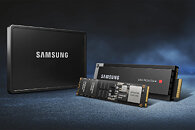- Joined
- Oct 9, 2007
- Messages
- 47,498 (7.49/day)
- Location
- Hyderabad, India
| System Name | RBMK-1000 |
|---|---|
| Processor | AMD Ryzen 7 5700G |
| Motherboard | ASUS ROG Strix B450-E Gaming |
| Cooling | DeepCool Gammax L240 V2 |
| Memory | 2x 8GB G.Skill Sniper X |
| Video Card(s) | Palit GeForce RTX 2080 SUPER GameRock |
| Storage | Western Digital Black NVMe 512GB |
| Display(s) | BenQ 1440p 60 Hz 27-inch |
| Case | Corsair Carbide 100R |
| Audio Device(s) | ASUS SupremeFX S1220A |
| Power Supply | Cooler Master MWE Gold 650W |
| Mouse | ASUS ROG Strix Impact |
| Keyboard | Gamdias Hermes E2 |
| Software | Windows 11 Pro |
Samsung is preparing to launch its 9th Generation V-NAND (3D NAND flash) memory next month, Korean publication Hankyung reports. The 9th Gen 3D NAND flash memory by Samsung is expected to offer 290 layers, a step-up from the 236-layer 8th Gen V-NAND that the company debuted in 2022. Samsung reportedly achieved the 290-layer vertical stacking density through improvements in its flash layer stacking techniques that relies on increasing the layer counts through more memory holes in the flash layer. The cost here is data density per wafer, but a net gain from the increase in layer counts.
The same source behind the 9th Gen V-NAND story also reports that the company is targeting a rather early 2025 launch for its successor—the 10th Gen V-NAND. This is expected to be a mammoth 430-layer 3D NAND flash, a jump of 140 layers over the 9th Gen (which itself jumped by 54 layers over its predecessor). This would put Samsung back on track along with its competitors, Kioxia, SK Hynix, Micron Technology, and YMTC, as they gun for the ambitious goal of 1000-layer 3D NAND flash by 2030.

Many Thanks to TumbleGeorge for the tip.
View at TechPowerUp Main Site | Source
The same source behind the 9th Gen V-NAND story also reports that the company is targeting a rather early 2025 launch for its successor—the 10th Gen V-NAND. This is expected to be a mammoth 430-layer 3D NAND flash, a jump of 140 layers over the 9th Gen (which itself jumped by 54 layers over its predecessor). This would put Samsung back on track along with its competitors, Kioxia, SK Hynix, Micron Technology, and YMTC, as they gun for the ambitious goal of 1000-layer 3D NAND flash by 2030.

Many Thanks to TumbleGeorge for the tip.
View at TechPowerUp Main Site | Source






